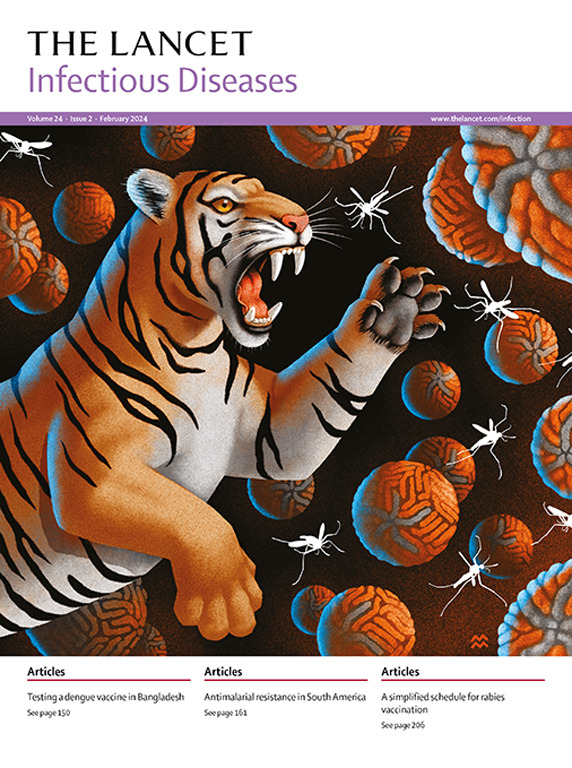Efficacy and safety of ascending doses of emodepside in comparison with ivermectin in adults infected with Strongyloides stercoralis in Laos: a phase 2a, dose-ranging, randomised, parallel-group, placebo-controlled, single-blind clinical trial
IF 36.4
1区 医学
Q1 INFECTIOUS DISEASES
引用次数: 0
Abstract
Background
Strongyloidiasis is a pernicious, sometimes fatal, infectious disease caused by the parasitic nematode Strongyloides stercoralis and infects millions of people worldwide. Ivermectin is the only recommended single-dose treatment option available, but concerns of drug resistance are rightly founded, therefore driving the demand for efficacious alternatives. Emodepside, an anthelmintic recently repurposed from the veterinary field, is currently under clinical development for the treatment of onchocerciasis and soil-transmitted helminthiasis. We aimed to identify the most efficacious and safe dose of emodepside against S stercoralis infections.Methods
We conducted a phase 2a, dose-ranging, randomised, parallel-group, placebo-controlled, single-blind clinical trial. Recruitment took place in 17 endemic villages in the Champhone district of Laos. Adults aged 18–60 years who provided three stool samples with a mean number of S stercoralis larvae per g of at least 0·75, as assessed by sextuplicate Baermann assays, were invited to participate. Clinically eligible participants were randomly assigned (1:1:1:1:1:1:1:1) to receive a single oral dose of placebo, ivermectin (200 μg/kg), or emodepside at doses 5 mg, 10 mg, 15 mg, 20 mg, 25 mg, or 30 mg. The participants, laboratory technicians, study nurses, and physicians were masked to the treatment assignments; study investigators were not masked. Participants providing at least one sample during follow-up were included in the primary outcome analysis, whereby efficacy was estimated by cure rate (defined as the proportion of participants who became S stercoralis negative 14–21 days after treatment). Treated patients were assessed for adverse events at 3-h, 24-h, 72-h, and 14 days post-treatment. This trial is registered at ClinicalTrials.gov (NCT06373835) and is completed.Findings
Between May 20, 2024, and Aug 14, 2024, 820 individuals were screened for S stercoralis infection and, of these, 202 individuals (108 male and 94 female) were randomly allocated to treatment groups and treated. 25 participants were treated with ivermectin, 25 with placebo, 25 participants with emodepside at 5 mg, 15 mg, 25 mg, or 30 mg dose, and 26 participants with emodepside at 10 mg or 20 mg dose. 5 mg emodepside had a predicted cure rate of 78·3% (95% CI 59·4–89·9), which was higher than the observed cure rate in the placebo treatment group (0%; 0·0–13·7; 0 of 25 participants). The dose–response curve plateaued at 15 mg, with a predicted cure rate of 89·1% (81·6–93·7). The observed cure rate in the ivermectin treatment group was 88·0% (68·8–97·5; 22 of 25 participants). The most common adverse event in all treatment groups was somnolence at 3-h post-treatment (ranging from nine [36%] of 25 participants in the emodepside 15 mg group to 17 [68%] of 25 in the 30 mg group). Other common adverse events included vision blur (two [8%] of 25 participants in the ivermectin group to 11 [44%] of 25 in the emodepside 30 mg group at 3-h post-treatment), vision impairment (three [4%] of 26 in the 10 mg group to eight [32%] of 25 in the emodepside 30 mg group), and dizziness (two [8%] of 25 participants in the emodepside 5 mg group to seven [28%] of 25 in the emodepside 30 mg group) at 3-h post-treatment. Adverse events were predominantly mild in nature and no serious adverse events occurred.Interpretation
At all doses tested, emodepside was efficacious and well tolerated in individuals infected with S stercoralis. The broad-spectrum weight-independent dose and robust safety profile positions emodepside as a promising new candidate for strongyloidiasis treatment.Funding
European Research Council and the Uniscientia Foundation.递增剂量的emodepside与伊维菌素在老挝成人粪圆形线虫感染中的疗效和安全性比较:一项2a期、剂量范围、随机、平行组、安慰剂对照、单盲临床试验
背景类圆线虫病是一种有害的,有时是致命的传染病,由寄生线虫粪圆线虫引起,全世界有数百万人感染。伊维菌素是唯一推荐的单剂量治疗方案,但对耐药性的担忧是有根据的,因此推动了对有效替代方案的需求。Emodepside是一种最近从兽医领域重新利用的驱虫药,目前正在临床开发中,用于治疗盘尾丝虫病和土壤传播的蠕虫病。我们的目的是确定最有效和安全的剂量的emodepide抗S粪虫感染。方法:我们进行了一项2a期、剂量范围、随机、平行组、安慰剂对照、单盲临床试验。招募工作在老挝Champhone地区的17个流行村庄进行。邀请年龄在18-60岁的成年人提供三份粪便样本,经六次重复Baermann测定,每克粪虫幼虫的平均数量至少为0.75。符合临床条件的受试者被随机分配(1:1:1:1:1:1:1)接受单次口服剂量的安慰剂、伊维菌素(200 μg/kg)或莫地苷,剂量分别为5mg、10mg、15mg、20mg、25mg或30mg。参与者、实验室技术人员、研究护士和医生对治疗任务不知情;研究人员没有被蒙面。在随访期间提供至少一个样本的参与者被纳入主要结局分析,通过治愈率(定义为治疗后14-21天成为粪球菌阴性的参与者的比例)来评估疗效。在治疗后3小时、24小时、72小时和14天评估治疗患者的不良事件。该试验已在ClinicalTrials.gov注册(NCT06373835)并已完成。结果在2024年5月20日至2024年8月14日期间,对820例个体进行了粪虫感染筛查,其中202例(男性108例,女性94例)被随机分配到治疗组进行治疗。25名受试者接受伊维菌素治疗,25名受试者接受安慰剂治疗,25名受试者接受5 mg、15 mg、25 mg或30 mg剂量的emodepside治疗,26名受试者接受10 mg或20 mg剂量的emodepside治疗。5 mg莫地苷的预测治愈率为78.3% (95% CI为59.4 - 89.9),高于安慰剂治疗组的观察治愈率(0%;0 * 0 - 13 * 7;25人中的0人)。剂量-反应曲线在15 mg处趋于稳定,预测治愈率为83.1%(86.1 ~ 93.7)。伊维菌素治疗组观察治愈率为88.0% (68.8 ~ 97.5%;25名参与者中的22名)。所有治疗组中最常见的不良事件是治疗后3小时嗜睡(emodepside 15 mg组25名参与者中有9名[36%]至30 mg组25名参与者中有17名[68%])。其他常见的不良事件包括视力模糊(两个25(8%)参与者伊维菌素组11(44%)的25 emodepside 30毫克组3 - h后处理),视力障碍(三[4%]26 10毫克组8(32%)的25 emodepside 30毫克组),和眩晕(两个25(8%)的参与者emodepside 5毫克组7 [28%]25 emodepside 30毫克组)3 - h后处理。不良事件以轻度为主,未发生严重不良事件。在所有剂量的测试中,emodepide对粪虫感染个体有效且耐受性良好。emodepside的广谱剂量和强大的安全性使其成为治疗类圆线虫病的新候选药物。资助欧洲研究委员会和Uniscientia基金会。
本文章由计算机程序翻译,如有差异,请以英文原文为准。
求助全文
约1分钟内获得全文
求助全文
来源期刊

Lancet Infectious Diseases
医学-传染病学
CiteScore
60.90
自引率
0.70%
发文量
1064
审稿时长
6-12 weeks
期刊介绍:
The Lancet Infectious Diseases was launched in August, 2001, and is a lively monthly journal of original research, review, opinion, and news covering international issues relevant to clinical infectious diseases specialists worldwide.The infectious diseases journal aims to be a world-leading publication, featuring original research that advocates change or sheds light on clinical practices related to infectious diseases. The journal prioritizes articles with the potential to impact clinical practice or influence perspectives. Content covers a wide range of topics, including anti-infective therapy and immunization, bacterial, viral, fungal, and parasitic infections, emerging infectious diseases, HIV/AIDS, malaria, tuberculosis, mycobacterial infections, infection control, infectious diseases epidemiology, neglected tropical diseases, and travel medicine. Informative reviews on any subject linked to infectious diseases and human health are also welcomed.
 求助内容:
求助内容: 应助结果提醒方式:
应助结果提醒方式:


